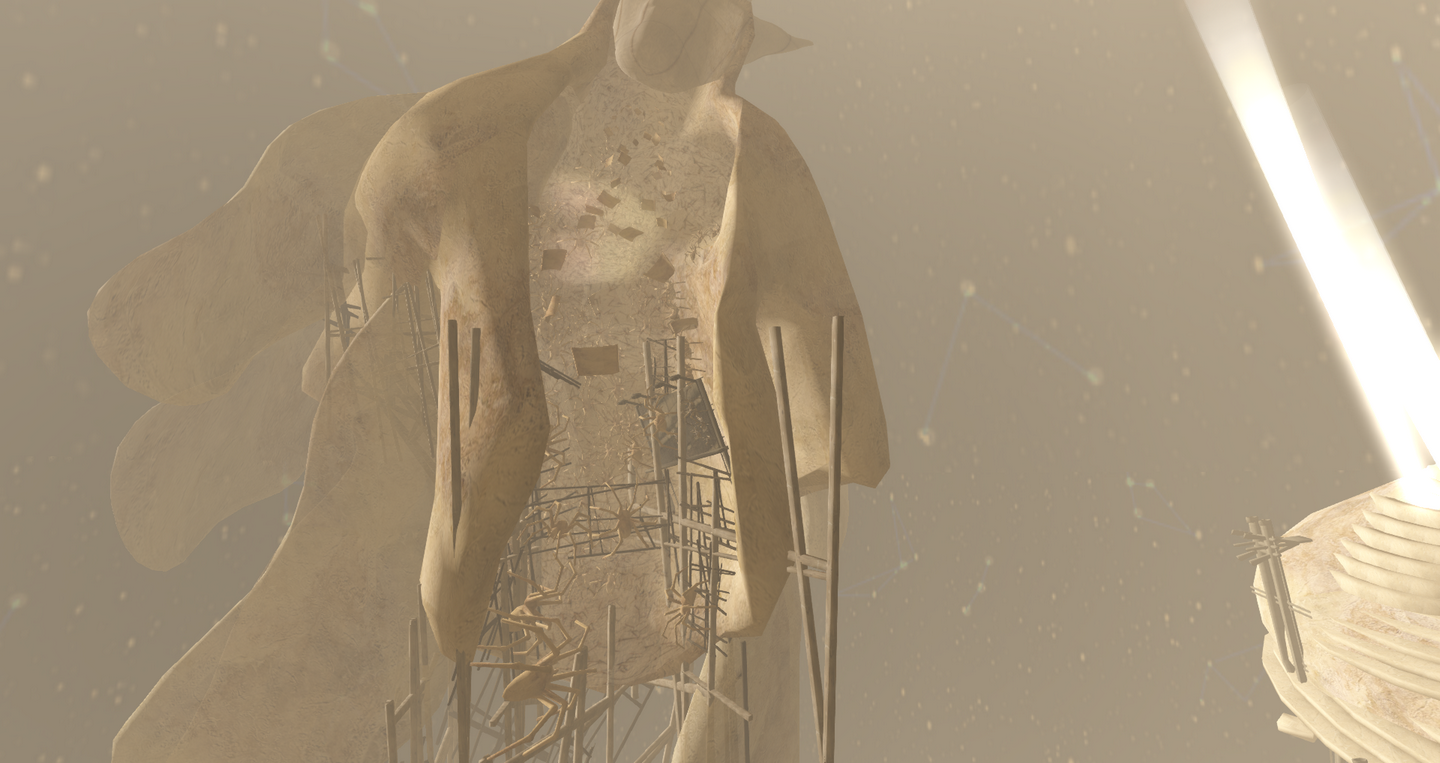In a post some time ago, I criticized artists who strive to impart a message but produce banal art. Haveit often has a message, but he also has the artistic skills to support it. City Inside Out concerns the homeless, or more precisely, the experiences of the homeless. This is a highly complex work, with three levels and many locations at each, all of them exteriors. The ground level is perhaps the most straightforwardly representational, dominated by a highway speeding underfoot, a huge network of footbridges rising impossibly into the sky, road signs, and billboards. But there are also a few oddities, like a small pile of giant, somewhat ghostly distorted chairs.
|
|
|
City Inside Out -- ground level
There is a huge gouge in the ground, and walking (or falling) down it leads to the entrance to the lower level, guarded by two ominous serpents – as medieval maps say, "Here there be dragons." Down the path one reaches what appears to be a welcoming house, but when you enter the open door you find yourself in a large city (with Haveit's characteristic nineteenth-century façades). Although the edifices initially give a realistic feel to the setting, the entire level has many symbolic elements, some of them on the buildings themselves. Overhead, a huge ship is going to pieces, like the shipwreck that is most homeless people's lives; the hulk of another ship already lies at the bottom. A pack of dogs roams the street. The large, classically-styled front of a building (a bank, courthouse or City Hall) faces the street, but the emblem on its pediment is a devil, and although one can peer in, one cannot actually go inside, and what one actually sees there is yet another exterior. Elsewhere a porch has another open door, but through it there's a completely modern urban seating area, marred by graffiti, warped streetlamps, and benches built to prevent sleeping. Welcome to the unwelcoming city.
|
|
|
|
|
|
City Inside Out -- underground level
The upper level (one can get there from the stairways at the ground level) is the most phantasmagorical. Dogs tug at leashes while others are already running loose. Shrimp are flying in the sky. Misshapen towers loom overhead, leaning precariously. A ship sails in the air, split fore and aft, its sails torn to tatters. Billboards and telephone poles are scattered around. Devils survey the action. There are some enclosed spaces but once again they present exterior scenes. And then there are the bugs. As in a painting by Hieronymus Bosch (recalled by other aspects of this scene), inanimate objects have sprouted legs and scurry about as new torments. The locusts of homelessness are wine bottles and handguns; what should be a warm coat is infested with spiders and whirling debris.|
|
|
|
|
|
City Inside Out -- sky level
I have described only some of the locations in City Inside Out; one can easily explore this complex work for an hour, and one should spend at least that long.
What a contrast, then, to The Centaurs' Hall. Centaurs are a frequent motif in Haveit's work. These elegant and majestic creatures, as a book in the building explains, are able to fly by the sheer force of absorbing air into their lungs and rapidly breathing. These are creatures of the spirit. Here he presents their mansion – their home, and a monument to themselves. Unlike the city of City Inside Out, the hall literally welcomes visitors inside. Two telescopes stand along a walkway, testaments to the centaurs' intelligence and ingenuity. Inside a greenhouse, tables are spread with fine foods and drink free for the taking, to be accompanied by a violin and the soft tinkling of a blue centaur-shaped fountain. Golden-robed statues line the main hallway. Reflecting the centaurs' spirit, this is a place of beauty and sensitivity – but also opulence. There is, I think, a dark side to this installation. The Centaur's Hall is the noble castle of the Haves, a contrast to urban environment of City Inside Out, the acidic non-home of the Have-Nots.
|
|
|
|
|
|
The Centaur's Hall
And something seems awry. Those deer wandering down the hall – are they symbols of the centaurs' unity with nature, or signs that the building is being abandoned? Is that a devil pointing upwards to where spirits seemed to be swirling about, perhaps trying to escape? And most of all, who are those human-like figures struggling on the ground? There is something desolate about this place, something decaying, and even though the food still has steam rising from it, one gets the feeling that it has stood on those tables for a long time.
I don't know if Haveit intended these two installations to contrast each other; I tend to doubt it, but contrast they do. The question underlying these works is "Who lives in what way?" On the bottom floor of The Centaurs' Hall, he has installed a small version of The Miniature Goal from about a year ago, a work about the worldwide depletion of resources. The phrase "living in reduced circumstances" takes a new meaning here as city buildings shrink to uninhabitability. If we continue to live this way, the installation seems to say, soon we shall all of us be homeless.
The Centaurs' Hall: http://maps.secondlife.com/secondlife/Verdigris/180/69/56
City Inside Out: http://maps.secondlife.com/secondlife/LEA20/138/129/22













